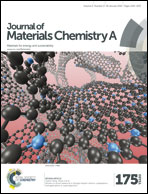Optimized thermoelectric properties in pseudocubic diamond-like CuGaTe2 compounds
Abstract
A pseudocubic structure approach has been proposed recently to screen and design good thermoelectric materials via realizing overlapped band edges for excellent electrical transport properties. A diamond-like compound is a typical example agreeing with the concept of the pseudocubic structure by tuning its lattice distortion parameter to unity. However, besides the band structure, optimized carrier concentration and reduced lattice thermal conductivity are also required for a high thermoelectric figure of merit (zT). In this work, taking CuGaTe2 as an example, we have successfully demonstrated that Cu-deficiency can effectively tune carrier concentrations and In-alloying at Ga sites can effectively lower lattice thermal conductivity. By combining these two strategies, the electrical and thermal transports can be separately optimized in CuGaTe2-based pseudocubic diamond-like compounds, leading to much enhanced zTs, about 24% improvement for Cu0.99In0.6Ga0.4Te2 at 800 K. Furthermore, the average zTs from 300 K to 800 K are improved by 87% compared with that of the CuGaTe2 matrix. This study provides a promising way to optimize the TE performance in pseudocubic diamond-like compounds by simultaneously tuning electrical and thermal transport.


 Please wait while we load your content...
Please wait while we load your content...